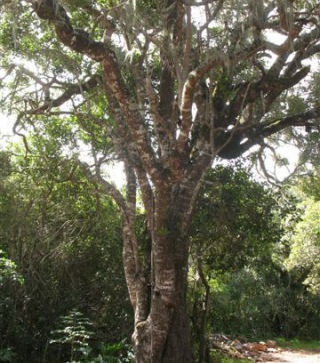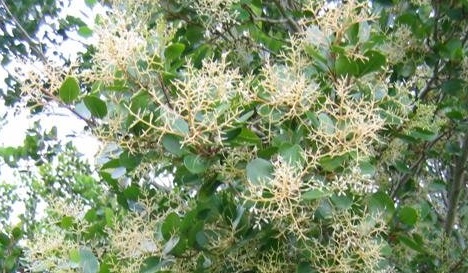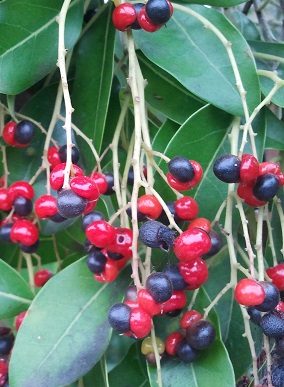White Pear – Apodytes dimidiata
(Witpeer)
In South Africa, the White Pear is widely distributed in both coastal and montane, evergreen forest, occuring alike along the eastern escarpment, reaching is best development in the Knysna region.
The Tree
It is a small to large evergreen tree and can reach up to a height of 25m in the forest, but is smaller when growing in the open.
The stem is usually long and straight, and the crown is small. Older stems often develop coppice shoots.
The bark is pale grey or whitish and rather smooth with large grey, brown or orange patches, usually with horizontal markings. On young branches the bark can be smooth and pinkish to purplish, with a ridge running down from either side of the leaf stalk. In the forest the trunks can grow up to 2,5m in diameter.

The small flowers are white and sweet scented and the petals usually curl backwards. After good rains they are profuse in terminal sprays of about 8 cm. October – April.
The fruit is a flattened black drupe with a fleshy appendage which ripens from green to scarlet, and then black. It is about the size of a small pea. Fresh seed germinate in 10-12 months and the young trees grow quite slowly. December – June.
Properties
The heartwood is yellowish- to pinkish-brown and the sapwood is grey and indistinct. The wood is pale and close-grained, with uneven brown shades. It is straight-grained, very fine and even textured, strong and elastic, hard and heavy, with little or no figure. Centres of the logs are often marked by darker wood, the result of incipient decay.
Woodworking Properties
The wood saws without difficulty to true edges. It planes to a lustrous, smooth finish. The wood has good nailing properties, glues well and polishes to a high finish. The wood has good bending properties and is excellent for turning.
Using the Wood
These trees used to be very abundant in the Knysna forests, where it used to be one of the important sources of wood. Today it is still much sought after, although the pith may often be rotten.
The wood is remarkably hard for its density and is suitable for furniture, cabinetry, joinery, interior trimming, musical instruments, gun stocks, decorative items, carving and turnery. Also recommended for domestic flooring, boat building, sports equipment, drawing instruments and tables. Formally one of the most valued wagon-woods where this wood was considered the most suitable for cart and wagon felloes.
Green weight: 1105 kg/m3
Dry weight: 800 kg/m3
Source: Trees of the Garden Route / Elna Venter
Southern African Woods / Stephanie Dyer, Barry James & Danielle James
If you are looking to buy wood, please click here to visit our Timber slab sales page.



